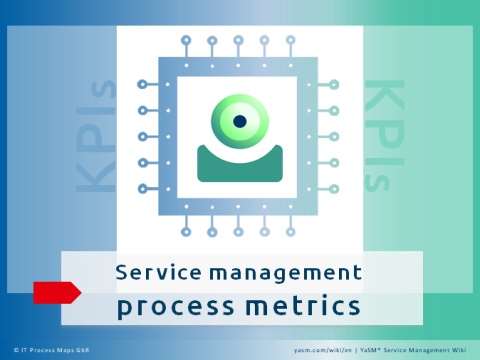Service Management Metrics
Process metrics (at times also referred to as "key performance indicators" or "KPIs") are used to assess if the service management processes are running according to expectations.
Proceed to: Process metrics for the service lifecycle processes | Process metrics for the supporting service management processes
Defining process metrics
Defining suitable metrics is above all about deciding what exactly is considered "successful" process execution. Once this is established, suitable metrics can be defined and subsequently measured. The process owners are then in a position to evaluate the quality of their processes, which in turn is the basis for process improvement.
The exact definitions of the metrics will vary depending on the nature of the service provider organization, so the metrics contained in this wiki can only be suggestions.
Generally speaking, there is no shortage of recommendations for service management metrics. If further ideas are needed, the various service management frameworks like ITIL® [1], COBIT® [2] and USMBOK™ [3] may be consulted - but we advise using a focused set of metrics or KPIs that can be managed and acted upon in the long term.
A widely accepted principle holds that process metrics should be SMART:
- Specific
- Measurable
- Achievable
- Result-oriented
- Timely.
Quantitative and qualitative metrics
When developing sets of process metrics, a distinction is often made between quantitative metrics and qualitative metrics (although the line between the two may at times be blurred):
- As the name suggests, quantitative metrics are typically straightforward measurements of volumes and frequencies (e.g. the number of service requests reported to 1st level support). Such metrics may not say much about the quality of the service request fulfillment process, but they can be useful for managing the resources required to fulfill service requests.
- Qualitative metrics have a more direct relationship to successful process execution. For example, if a service provider aims to resolve a high percentage of incidents directly in 1st level support, the 1st-line resolution rate would be a suitable qualitative metric.
Metrics: Service lifecycle processes
Process metrics for the service lifecycle processes (LP):
- LP1: Set the strategic direction
- LP2: Design new or changed services
- LP3: Build new or changed services
- LP4: Operate the services
- LP5: Improve the services
Metrics: Supporting processes
Process metrics for the supporting service management processes (SP):
- SP1: Set up and maintain the service management system
- SP2: Maintain the service portfolio
- SP3: Manage customer relationships
- SP4: Manage configuration information
- SP5: Assess and coordinate changes
- SP6: Manage projects
- SP7: Ensure security
- SP8: Prepare for disaster events
- SP9: Ensure compliance
- SP10: Manage human resources
- SP11: Manage suppliers
- SP12: Manage service financials
Notes
[1] ITIL® is a registered trade mark of AXELOS Limited.
[2] COBIT® is a registered trademark of ISACA (Information Systems Audit and Control Association).
[3] USMBOK™ is a registered trade mark of Virtual Knowledge Solutions International Incorporated (VKSII).
By: Andrea Kempter ![]() and Stefan Kempter
and Stefan Kempter ![]() , IT Process Maps.
, IT Process Maps.
Defining process metrics › Quantitative vs. qualitative metrics › Metrics: Service lifecycle processes › Metrics: Supporting processes





